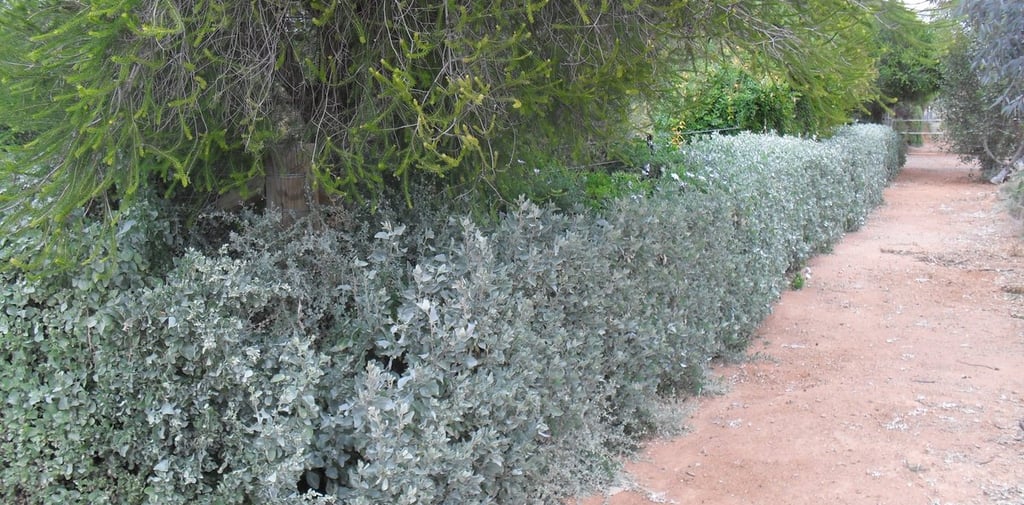Managing Alkaline Vertisol with the Right Plants


Gardeners often face the challenge of improving alkaline vertisol, especially when it has been long irrigated with bore water. Such soil can be tough on plants, leading to wasted time, energy, and money. Here's a practical guide to transforming your yard into a thriving, resilient garden by using plants that enhance soil health and improve conditions over time.
Vertisol is a type of clay-rich soil that expands and contracts significantly with changes in moisture. This creates deep cracks during dry periods. Found in regions with distinct wet and dry seasons, vertisols form from clay minerals that swell when wet and shrink when dry, giving them a unique structure. In Winton, vertisols have developed due to the region's climate and geological history, which includes alternating wet and dry cycles. Natural processes continue to form and maintain vertisols, making them a permanent feature of Winton's landscape. Vertisols' cracking and movement have Winton renowned for paleontological finds. While this offers incredible insights into Earth's natural history, it also presents challenges for gardening that demand innovative solutions.
High clay content in vertisols limits water drainage and air circulation, making it difficult for plants to establish healthy roots. Long-term irrigation with bore water can increase soil salinity and alkalinity, compounding gardening difficulties.
The Right Plants for Improving Alkaline Vertisol
1. Salt Bush (Atriplex nummularia): is salt-tolerant with deep roots that break up dense clay. It improves soil structure, adds organic matter, and boosts microbial activity. Salt Bush makes a great hedge, with a silver appearance and compact growth that enhances your garden's visual appeal.
2. Acacias (Acacia spp.): are nitrogen-fixing plants that enrich the soil. They enhance soil stability, structure, and nutrient availability. Not all Acacias are towering trees with yellow flowers. For instance, Vanilla Wattle (Acacia redolens) is a low-growing ground cover, tolerant of salt and drought, emitting a pleasant vanilla fragrance. It's widely used in large-scale landscaping in the United States due to its hardiness and minimal maintenance requirements.
3. Marigolds (Tagetes spp.): are a natural pest repellent. They control nematode populations and promote healthier roots. Marigolds' strong scent confuses rodents' sense of smell, helping to deter them from your garden.
4. Purslane (Portulaca oleracea): acts as ground cover, accumulating essential nutrients. It reduces soil erosion, conserves moisture, and enhances nutrient availability. Purslane already grows in Winton and is not only nutritious but also delicious, making it a great addition to your diet.
5. Allocasuarinas and Casuarinas (Sheoaks): are nitrogen-fixing trees that thrive in alkaline soils. They improve soil structure, add organic matter, and enrich soil with nitrogen. Sheoaks provide habitat for the threatened Black Cockatoo, act as excellent windbreaks and shade providers, and their rustling needles create a soothing sound in the breeze, enhancing your garden's ambience. They drop pine needles, which can be used as mulch to further improve soil conditions.
6. Rosella (Hibiscus sabdariffa): grows well for a year and then dies back, allowing its pruned branches to be cut and dropped as mulch. The remaining roots help maintain soil structure and prevent erosion while the dropped branches add organic matter, enriching the soil. Rosella is not only beneficial for the soil but also produces edible calyxes that can be used in various culinary dishes, adding value to your garden.
Setting Up Your Garden
Aim for autumn or early spring when temperatures are mild and there's sufficient moisture. Choose sunny spots for these plants as they generally require full sunlight. Consider prevailing wind directions and plant windbreaks like Sheoaks accordingly. Check soil salinity and pH levels. Amend with gypsum to reduce salinity and add compost or organic matter to improve soil structure and fertility. Instead of digging into flat ground, mound up soil to create planting areas above the vertisol. This prevents plants from sitting in waterlogged holes with clay sides, which can lead to root rot. Dig holes in the mounded soil slightly larger than the root ball. Place plants, fill with amended soil, and water thoroughly. Ensure the root crown is level with or slightly above the surrounding soil to prevent waterlogging. Once your foundational plants are established and thriving, you can introduce other interesting plants suited to your amended soil conditions. Choose plants that complement your existing garden layout and fulfil specific aesthetic or functional needs, such as flowering plants for pollinators or herbs for culinary use. Regularly check soil health through testing and observation. Adjust watering and amend soil as needed. By following these straightforward steps and selecting suitable plants like Salt Bush, Acacias, Marigolds, Purslane, Allocasuarinas, and Casuarinas, you can create a thriving garden even in challenging vertisol soil. This approach not only saves time, energy, and money but also results in a beautiful, sustainable garden that supports diverse plant and soil life.
